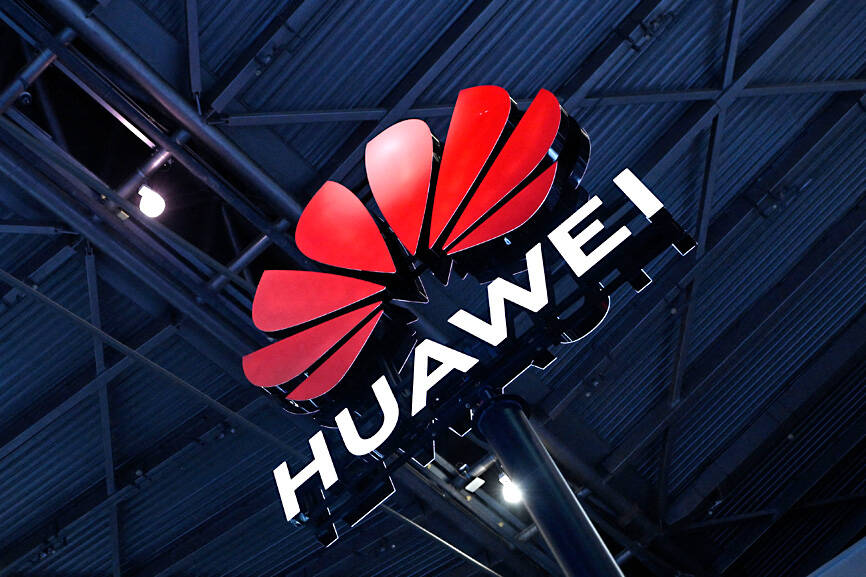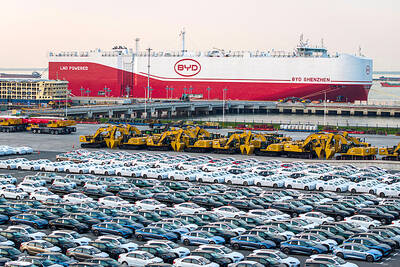Huawei Technologies Co’s (華為) revenue surged 9 percent this year, capping a dramatic year for the Chinese technology powerhouse, which challenged Apple Inc and US sanctions with an apparent breakthrough in chip technology.
Sales jumped to more than 700 billion yuan (US$98.7 billion), their fastest pace of growth in years thanks to a resurgent smartphone business and robust 5G equipment sales. On a quarterly basis, revenue climbed 27 percent to at least 243.4 billion yuan, based on Bloomberg’s calculations off the annual figure, which is a sharp acceleration from the third quarter’s slight rise.
Huawei made a splash this year after releasing a smartphone with a sophisticated made-in-China 7-nanometer Kirin processor, celebrated across China over US restrictions intended to hobble the country’s tech industry. The revelation ignited debate in Washington over whether those curbs had failed and what more needed to be done.

Photo: AFP
Huawei, written off as a top smartphone player after the US cut it off from overseas suppliers in 2019, is mounting a comeback. The Shenzhen-based conglomerate has emerged as a symbol of China’s resolve to thwart its geopolitical rival’s curbs, but Huawei itself warned of the dangers Washington and a volatile global economy might pose next year.
“After years of hard work, we’ve managed to weather the storm. And now we’re pretty much back on track,” Ken Hu (胡厚崑), one of several executives who rotate into the chairperson’s role, said in a traditional end-of-year message to staff. “We have to be aware that changes in the business environment are not caused by geopolitical conflict alone, but also by fluctuating global economic cycles.”
Huawei has enjoyed strong support domestically since its 2019 blacklisting. State-owned telecom carriers awarded Huawei lucrative deals in 5G and cloud computing, and other institutions bought nonperforming businesses from the company.
The Mate 60 Pro — the gadget housing the 7-nanometer Kirin 9000S chip — has taken market share away from Apple’s iPhone 15 since its August launch. Huawei has morphed into a major player in semiconductors, the very sector the administration of US President Joe Biden is focused on curtailing.
Huawei, a leader in networking equipment and smartphones, is establishing a network of chip plants and receiving an estimated US$30 billion from the Chinese government and its own hometown of Shenzhen, the US Semiconductor Industry Association said.
Going into the new year, Huawei might have to contend with not just a persistent US campaign to contain China, but also pressure to keep up its technological advances.
That last might become more difficult as already-scarce critical components for chipmaking, such as equipment, become further strained.
US Secretary of Commerce Gina Raimondo has said the US will take the “strongest possible” action to protect its national security when asked how she would respond to Huawei’s breakthrough.
To ensure its technological lead, Huawei aims to expand investment in emerging technologies such as artificial intelligence.
“We need to proactively embrace this window of opportunity and invest our limited resources in the most critical strategic domains,” Hu wrote. “Our overall strategic direction is clear. We will continue to streamline HQ, simplify management, and ensure consistent policy, while making adjustments where needed.”

Micron Memory Taiwan Co (台灣美光), a subsidiary of US memorychip maker Micron Technology Inc, has been granted a NT$4.7 billion (US$149.5 million) subsidy under the Ministry of Economic Affairs A+ Corporate Innovation and R&D Enhancement program, the ministry said yesterday. The US memorychip maker’s program aims to back the development of high-performance and high-bandwidth memory chips with a total budget of NT$11.75 billion, the ministry said. Aside from the government funding, Micron is to inject the remaining investment of NT$7.06 billion as the company applied to participate the government’s Global Innovation Partnership Program to deepen technology cooperation, a ministry official told the

Taiwan Semiconductor Manufacturing Co (TSMC, 台積電), the world’s leading advanced chipmaker, officially began volume production of its 2-nanometer chips in the fourth quarter of this year, according to a recent update on the company’s Web site. The low-key announcement confirms that TSMC, the go-to chipmaker for artificial intelligence (AI) hardware providers Nvidia Corp and iPhone maker Apple Inc, met its original roadmap for the next-generation technology. Production is currently centered at Fab 22 in Kaohsiung, utilizing the company’s first-generation nanosheet transistor technology. The new architecture achieves “full-node strides in performance and power consumption,” TSMC said. The company described the 2nm process as

POTENTIAL demand: Tesla’s chance of reclaiming its leadership in EVs seems uncertain, but breakthrough in full self-driving could help boost sales, an analyst said Chinese auto giant BYD Co (比亞迪) is poised to surpass Tesla Inc as the world’s biggest electric vehicle (EV) company in annual sales. The two groups are expected to soon publish their final figures for this year, and based on sales data so far this year, there is almost no chance the US company led by CEO Elon Musk would retain its leadership position. As of the end of last month, BYD, which also produces hybrid vehicles, had sold 2.07 million EVs. Tesla, for its part, had sold 1.22 million by the end of September. Tesla’s September figures included a one-time boost in

Shares in Taiwan closed at a new high yesterday, the first trading day of the new year, as contract chipmaker Taiwan Semiconductor Manufacturing Co (TSMC, 台積電) continued to break records amid an artificial intelligence (AI) boom, dealers said. The TAIEX closed up 386.21 points, or 1.33 percent, at 29,349.81, with turnover totaling NT$648.844 billion (US$20.65 billion). “Judging from a stronger Taiwan dollar against the US dollar, I think foreign institutional investors returned from the holidays and brought funds into the local market,” Concord Securities Co (康和證券) analyst Kerry Huang (黃志祺) said. “Foreign investors just rebuilt their positions with TSMC as their top target,